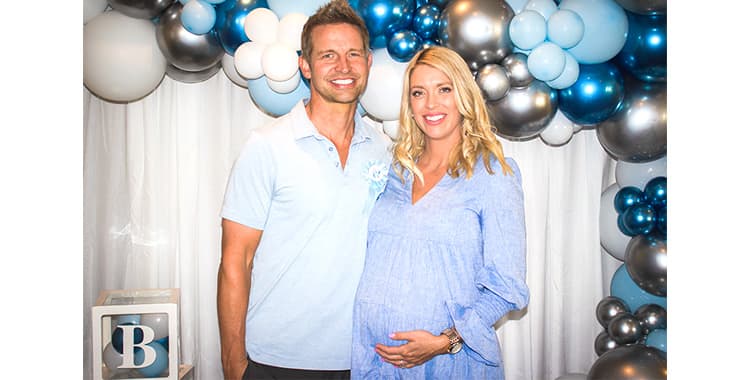
This article was written in September 2023.
Two short months after giving birth to almost 10-pound Kaden Samuel Kress, Veronica — the “V” in Chef V” — has lost 45 pounds of the 55 she gained. Just 10 more extra pregnancy pounds to shed and V will return to her pre-pregnancy shape. What’s her secret and tips for postpartum weight loss?

I’m stoked! I just got clearance from my OBGYN to resume my pickleball obsession, hit the gym and practice yoga. I’m soooo ready to get back to my active lifestyle. It’s not like I was a total sedentary sloth after giving birth to baby Kaden. I made sure to move around a little here and there. But giving birth is not only a miracle, it’s exhausting! Rest and recovery are just what the doctor ordered.
But going two months without engaging in my favorite physical activities was starting to drive me crazy. Being super active and then having to stop for weeks is like telling a tiger to ditch its stripes.
Despite feeling shackled and prohibited from doing high-impact exercise, the post-partum speed bump in my belly has almost completely flattened. And most importantly, I feel amazing. I’ve lost 45 of the 55 pounds I gained during my pregnancy. How did I do it without spending hours on the pickleball court or running on the beach and completely abstaining from serious exercise?

The Answer to V’s Post-Partum Weight Loss Success
Well, I’m not just the founder of ChefV.com, I’m also a client. And no B.S. here, I attribute my quick post-partum recovery to the foods I eat.
If you’re planning on giving birth soon or down the road and you want to know the secret to quick post-partum weight loss, I realize my answer might be disappointing.
Maybe you were hoping I’d reveal a few tricks. But completely getting rid of the pregnancy pounds is not magic. It’s actually very simple. It always comes down to diet. Pure and simple.
NOTE: 12/23 – Veronica lost all 55 pounds and tells you how she did it, what she learned about postpartum and gives you a meal plan for safely losing the baby bump. READ IT HERE

How Long Should It Take To Lose Pregnancy Weight?
Is it okay to take your time losing pregnancy weight? Nobody would blame you if you did. But you might not want to take too much time. That’s because according to a 2019 study published in the journal Nutrition, postpartum weight retention is both a short- and long-term risk factor for being overweight and obese. The researchers write, “Postpartum obesity has remained a clinical and public health challenge. The greater gestational weight gain is a strong predictor of higher postpartum weight retention.” In other words, the more weight you put on during pregnancy, the more weight you’ll have to lose after you give birth.
Again, it’s not rocket science.
But it’s not just how much you weigh after you give birth that’s at stake. It’s also your overall health. “The physiological and biological changes coupled with high-calorie intake and restricted physical activity may further augment the risk of higher postpartum weight retention, weight gain and related metabolic comorbidities later in life,” suggests a research study in an Indian OBGYN journal.
So what’s a decent goal for losing pregnancy weight? That same journal suggests that postpartum women with normal body weight but substantial postpartum weight retention — at least 10 pounds — as compared to pre-pregnancy body weight “should be motivated to attain pre-pregnancy body weight over a period of 12 months after delivery.”
How Quickly Should You Resume Exercise After Giving Birth?
That study from India I mentioned? It says that postpartum women with uncomplicated delivery should be encouraged to gradually resume physical activity within four to six weeks post-delivery or as soon as they feel comfortable.
Women with cesarean or complicated deliveries should gradually resume physical activity after their first postpartum check-up (i.e. six to eight weeks post-delivery).
No matter what, postpartum women “must be encouraged to engage in low impact exercises such as walking and gradually include core muscle group strengthening exercises,” the researchers suggest.
Shoot for building up to 5 days a week of 30 minutes of moderate-intensity exercise, including some muscle-strengthening activity.
Eat This, Not That For Post Partum Weight Loss
I love giving back. It’s a research-backed way to feel awesome. And one way I want to pass it on is to offer a free download of my e-cookbook, Making Cleansing Easier. If you follow the recipes, diet resources and instructions to a “V” then you should have no trouble losing the pregnancy pounds.
The appetizers, snacks, drinks, entrees and even desserts include powerful anti-inflammatory, nutrient-dense ingredients.
But look, everybody and post-partum body is different. Take it easy. Be kind to yourself. If it takes you 6-12 months to lose the baby weight, then so be it. In fact, it’s common for it to take that long. But your baby is a precious lifetime miracle, so focus more on that bundle of joy than the meaningless number on the scale. If you eat real food the overwhelming majority of the time, you’ll feel great and that’s what counts.
To your health—and baby’s!
Love,
Veronica “V” Wheat
Founder, ChefV.com


























